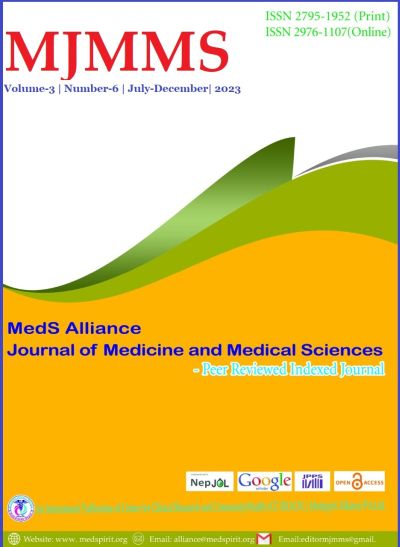Nutritional Disparities in Urban Aging: Ethnicity as culprit for Malnutrition in Ratnanagar Municipality
DOI:
https://doi.org/10.3126/mjmms.v3i6.66575Keywords:
Elderly, ethnicity, malnutrition, nutritional disparitiesAbstract
INTRODUCTION: Nutritional disparities in urban aging have emerged as a critical concern globally. As the aging population grows and urbanization accelerates, understanding the drivers of malnutrition among older adults in urban areas, especially across diverse ethnic groups becomes increasingly urgent. The study addresses the critical concern of malnutrition among older adults in urban areas, focusing on the influence of ethnicity on nutritional disparities.
MATERIALS AND METHODS: An analytical cross- sectional study was conducted among 341 elderly people aged above 60 years from March 2023 to August 2023 in Ratnanagar municipality of Chitwan. A systematic random sampling technique was employed to select participants from each ward. Face to face interview technique and anthropometric assessment was used in collecting data using semi-structured questionnaire comprising socio-demographic characteristics including ethnicity, life-style factors, dietary factors, functional status and nutritional status. Data analysis was performed using the Statistical Program for Social Sciences version 26.
RESULTS: The mean age of the participants was 69.86 years (SD = 7.72), with a range from 61 to 99 years. Of 317 participating elderly people, the prevalence of malnutrition and risk of malnutrition was 27.44% and 55.84% respectively. Dalit (50% malnourished, 50% at risk); Janajatis (31.50% malnourished, 57.48% at risk); Madeshi (33.33% malnourished, 50% at risk) and Muslim (20% malnourished, 60% at risk) respondents, categorized as disadvantaged, showed higher proportions of malnutrition or at-risk status; while Brahmin/Chhetri respondents considered advantaged, exhibited comparatively lesser proportion of malnutrition [1.79 (95% CI: 1.06-3.03)]. Likewise, disadvantaged ethnic group exhibited a significant AOR of 1.46 (95% CI: 1.05-2.89) for being at risk, compared to advantaged group.
CONCLUSIONS: There were significant disparities in nutritional status among older adults in Ratnanagar Municipality, with disadvantaged ethnic groups being particularly vulnerable to malnutrition. The findings of this study have important implications for public health policy and practice in Nepal.
Downloads
Downloads
Published
How to Cite
Issue
Section
License

This work is licensed under a Creative Commons Attribution-NonCommercial 4.0 International License.




